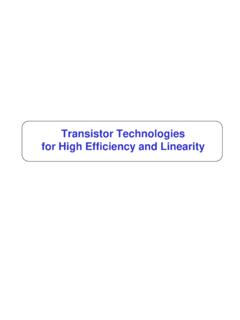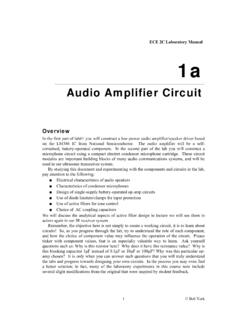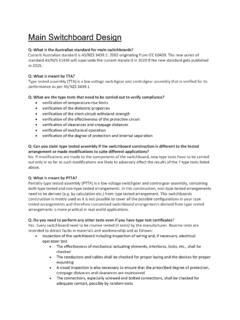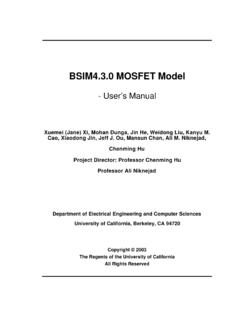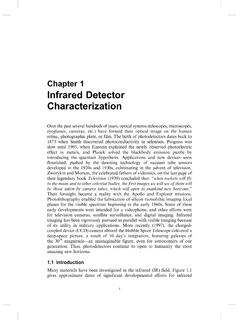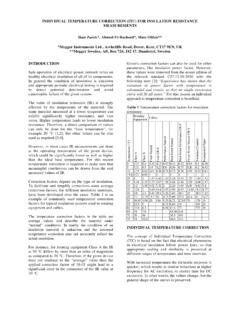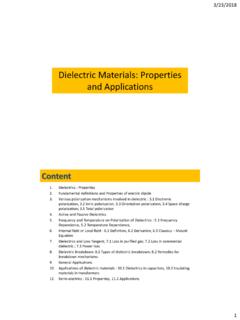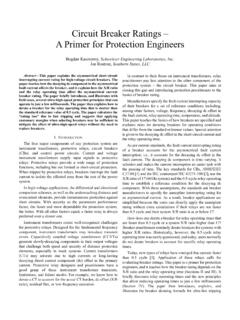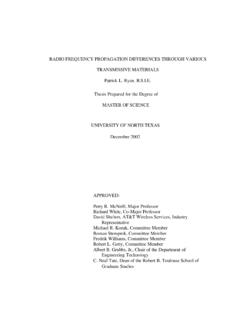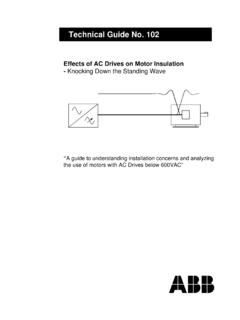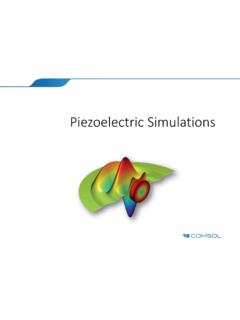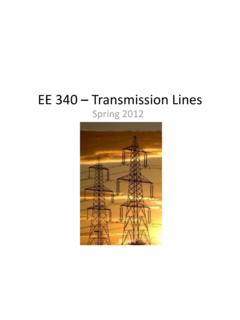Transcription of Quality factor, Q
1 Quality factor, Q Reactive components such as capacitors and inductors are often described with a figure of merit called Q. While it can be defined in many ways, it s most fundamental description is: dissipatedpoweraveragestoredenergyQ = Thus, it is a measure of the ratio of stored vs. lost energy per unit time. Note that this definition does not specify what type of system is required. Thus, it is quite general. Recall that an ideal reactive component (capacitor or inductor) stores energy 222121pkpkLIorCVE= Since any real component also has loss due to the resistive component, the average power dissipated is RVRIP pkpkavg22122== If we consider an example of a series resonant circuit.
2 At resonance, the reactances cancel out leaving just a peak voltage, Vpk, across the loss resistance, R. Thus, Ipk = Vpk/R is the maximum current which passes through all elements. Then, RCRLRILIQOO pkpkO 12222=== In terms of the series equivalent network for a capacitor shown above, its Q is given by: RXRCQ== 1 LRCLRC where we pretend that the capacitor is resonated with an ideal inductor at frequency . X is the capacitive reactance, and R is the series resistance. Since this Q refers only to the capacitor itself, in isolation from the rest of the circuit, it is called unloaded Q or QU. The higher the unloaded Q, the lower the loss. Notice that the Q decreases with frequency.
3 The unloaded Q of an inductor is given by oULQR = where R is a series resistance as described above. Note that Q is proportional to frequency for an inductor. The Q of an inductor will depend upon the wire diameter, core material (air, powdered iron, ferrite) and whether or not it is in a shielded metal can. It is easy to show that for a parallel resonant circuit, the Q is given by susceptance/conductance: GBQ= where B is the susceptance of the capacitor or inductor and G is the shunt conductance. Loaded Q. When a resonant circuit is connected to the outside world, its total losses (let s call them RP or GP) are combined with the source and load resistances, RS and RL.
4 For example, Here is a parallel resonant circuit (C,L and RP)connected to the outside. The total Q of this circuit is called the loaded Q or QL and is given by )||||(LSPoLRRRCQ = or LRPCRSRLLRPCRSRL tantanooLSLP totalCCsuscepceQGGGG conducce ===++ The significance of this is that QL can be used to predict the bandwidth of a resonant circuit. We can see that higher QL leads to narrower bandwidth. LoQBW = where 1oLC = 1. So, large C will increase the loaded Q at a given resonant frequency and reduce bandwidth. 2. Or, we could vary Gtotal. How? A. Unloaded Q (QU) is an attribute of the passive L and C components and affects GP. This will vary if we change L and C.
5 And, GP = GC + Gind, Capacitor: ()oUCCQ capacitorG = Inductor: 1()UoindQ inductorLG = Using this to set the bandwidth of a resonator is not a good idea. If QU becomes comparable to QL, then the loss in the resonator becomes very high as we shall see. Insertion Loss The resonator can be used as a bandpass filter or matching network. In these applications, insertion loss can be important. Consider this resonant LCR circuit. When w = wo, ()1outoSSSLPVjGVGGG =<++ Typically, GS = GL = G. We need to find S21 to determine insertion loss. Recall that |S21|2 = transducer gain = Power delivered to the load/available power from the source when the source and load are both Zo.
6 First note that 2 LPUPQGQG G=+ And, 212212outLSUPVQGSVQGG== =+ So, insertion loss (dB): 20 log 1 LUQILQ = Thus, narrow bandwidth where QL and QU are similar can be very lossy. GSCLGLVSGpVoutGSCLGLVSGpGSCLGLVSGpVoutHe re is an example of a simple resonant circuit. The unloaded Q is infinite, since no losses are included in the network. We see that there is no insertion loss in this case. Loaded Q varies from 1 to 10 with the given parameter sweep. Q=1 Q=10 Now, the circuit is modified to include a 500 ohm resistor (RP) in parallel with the LC network. This resistance represents the parallel equivalent loss due to both the L and the C. So, now we have a finite unloaded Q.
7 Note that the insertion loss increases as loaded Q, QL, approaches QU. Sweeping RLS, we see at resonance, the reactances cancel, and we are left with a resistive divider. Vout = Vin [R1/(2R1+RLS)]. S21 (dB) = 20 log(2 Vout/Vin) RLS=200 RLS=2000 So, we can set the QL and bandwidth by adjusting the loading conductances/resistances. oLBWQ = But, we must make sure that QU >> QL to avoid excessive losses. So, if really narrow bandwidth is required, the solution generally requires multiple resonators or more complicated bandpass filter approaches or mechanical structures like quartz crystal filters. 3. How can you set GS and GL? Aren t these dictated by the generator and load?
8 Not necessarily! We can use tapped C matching circuits to transform source and load impedances to whatever we desire (assuming we don t increase loss too much by approaching QU). But, first, we will introduce a convenient approximation which can be used to transform a parallel equivalent circuit into a series equivalent circuit and vice-versa. Example. Design bandpass matching network to transform 50 ohms to the input of an SA602 mixer. The mixer input impedance is given on the data sheet as ZIN = || 3 pF for the SA602 IC. Choose a convenient frequency for this exercise: 159 MHz = 1 x 109 rad/sec. Use the tapped C procedure to transform 50 ohms to 1500 ohms.
9 Include the 3 pF into the equivalent series capacitance of C1 and C2. The equivalent parallel resistance, RP, due to the unloaded Q of the components should also be taken into account in calculating the loaded Q and the transformation ratio needed to match the source and load. We need to specify a bandwidth to begin the process. Let s choose 10 MHz. 1591610LQ== QU is generally limited by the inductor. The manufacturer s data generally specifies an unloaded Q at a certain frequency. For a T-30-12 powdered iron core material, QU of 120 LOLOLOLOLOLORS = 50C2LC1Gp1500 ohms3 pF1500 ohmsRS = 50C2LC1Gp1500 ohms3 pF1500 ohmsis typical at this frequency. The external capacitors normally have a higher unloaded Q which can be neglected.
10 Our first design equations: 1120 UoPQLG == 1/16oLtotalSLPLBQGGGG ===++ Assume that GS = GL = 1 = x 10-4. That is, design the tapped C network to provide a transformed impedance of This will get close to the solution needed. So, now we have two equations with 2 unknowns. We can solve for L and for GP. GP = x 10-4S or RP = 4900 ohms. B = QU GP = x 10-2 S 141oLnHB == This is a rather small value and will require some care in layout to implement accurately on a PC board. Check insertion loss: 20 log = = If we required less loss, then a wider BW or higher QU is necessary. Next, design the tapped C network to give ||RP = 1150 ohms.

